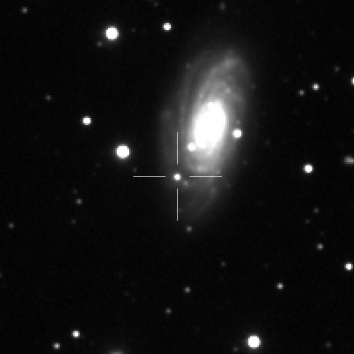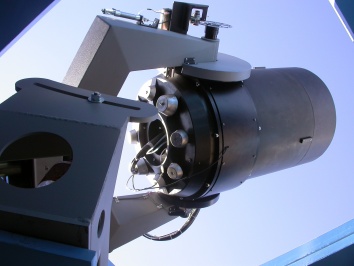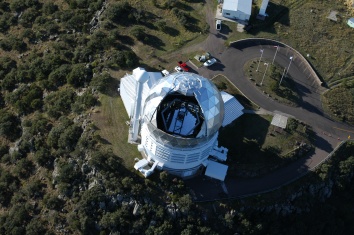Texas Supernova Search Finds Exploding Stars Fast, Follows Up Faster with Giant Telescope
10 January 2007
SEATTLE, Wash. — Robert Quimby, a post-doctoral researcher at The University of Texas at Austin, is heading up the Texas Supernova Search — an effort to detect exploding stars of all types in the fastest way possible after their explosion, to better understand how they explode and the types of stars they were prior to the explosion. This information will aid scientists using supernovae in cosmology studies, including the study of dark energy.
Quimby is explaining his search technique and results in a talk today at the 207th meeting of the American Astronomical Society in Seattle, Washington.
The search program uses ROTSE IIIb, a robotic telescope located at The University of Texas at Austin McDonald Observatory in West Texas. The telescope is one unit of four placed around the world that make up the Robotic Optical Transient Search Experiment headquartered at The University of Michigan. Its primary purpose is to quickly track gamma-ray bursts. However, 30 per cent of the telescope’s observing time is also available to The University of Texas for other studies like Quimby’s Texas Supernova Search, which uses most of that allocation.
The project has some advantages over other supernova searches. The telescope has an extremely large field of view — the width of 3.5 full Moons on a side (3.4 square degrees). Second, this project looks at the same patches of sky night after night, Quimby says, explaining that most other search projects don’t work this way. His winter/spring targets include three grids, which cover the Virgo, Ursa Major, and Coma galaxy clusters. Together, these fields include hundreds of nearby bright galaxies, and thousands of nearby dwarf galaxies. Finally, ROTSE IIIb shares mountaintop space with one of the largest optical telescopes in the world, the 9.2-meter Hobby-Eberly Telescope (HET). When a supernova is found by ROTSE, it can immediately be followed up in great detail with HET.
Since the fall of 2004, the Texas Supernova Search has found about 30 supernovae.
Quimby explains that while “hundreds of supernovae are found every year” now by various search groups, the idea behind his project is to try to get the earliest look at new supernovae. In other words, he says, “not to find the most supernovae, but to find the best supernovae.”
He explains that “when a supernova explodes, the material expands and thins out. When it fans out, you see deeper into the explosion. Most people studying supernovae are looking fairly deep” into the expanding debris cloud.
In contrast, “we look early,” he says. This enables him to study the exploded star’s outer layers, before the debris cloud has had much time to expand.
The benefit of catching supernovae as soon as possible after they explode, Quimby says, is to get information that is only available by studying the star’s outer layers. This includes information about the progenitor star, and about the explosion itself.
“There are very few examples of supernovae that have been studied in the first few days,” Quimby says — less than a dozen. His survey recently discovered one, known as supernova 2006bp. Quimby says the Texas Supernova Search found 2006bp about two days after it exploded. (It was independently reported earlier by amateur astronomer Koichi Itagaki of Yamagata, Japan.)
This early detection is important, because such studies might reveal differences in supernovae soon after they explode, which at later times look identical. The great value of supernovae (specifically, type Ia supernovae) to cosmology research is their uniformity — astronomers can count on them to have a certain peak luminosity for a given light curve shape, which allows them to calculate distance to the supernova (and its host galaxy) with great confidence. These measurements were integral, for instance, in the calculations that revealed that the expansion of the universe is accelerating, and introduced what many call the greatest enigma in science today — dark energy.
But what if all supernovae aren’t the same? Quimby’s search caught one exploded star that hints of this possibility: supernova 2005hj. Once the search found this supernova, they began following it as it changed day by day using the HET. Spectra taken over a period of time showed that the light output from this supernova changed over time in a way different from the norm.
“At first, the velocity of the ejecta decreased over time as is typical,” Quimby says. “But this was followed by about a two-week period of nearly constant velocities, which is unusual.”
Quimby says there are two possible explanations for 2005hj’s unusual behavior. It could be a merger of two white dwarf stars — the so-called “double degenerate” model. The second possibility is that it could be a white dwarf star that tried to explode, but didn’t release enough energy. So it puffed up a bit, then collapsed back onto the star’s core, triggering a second (much larger) explosion. This case is known as a “pulsating delayed detonation.”
The Texas Supernova Search will continue. Quimby hopes to expand the program to include all four ROTSE telescopes. Besides unit IIIb at McDonald Observatory, there are ROTSE telescopes in Australia, Turkey, and Namibia.
The Hobby-Eberly Telescope is a joint project of The University of Texas at Austin, The Pennsylvania State University, Stanford University, Ludwig-Maximilians-Universität München and Georg-August-Unversität Göttingen.
— END —
Note to Editors: Robert Quimby can be reached in Seattle this week by cell phone at 512-789-2094 and thereafter in Austin at 512-471-7460. He can also be contacted via email at quimby@astro.as.utexas.edu.









